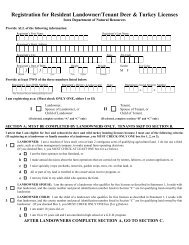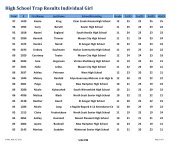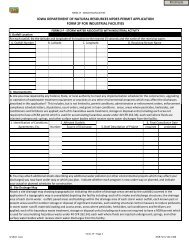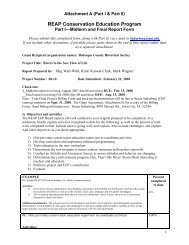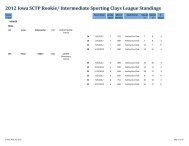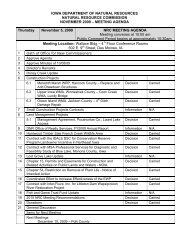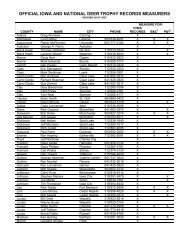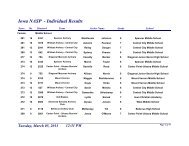Waste Reduction, Construction and Demolition Debris - Iowa ...
Waste Reduction, Construction and Demolition Debris - Iowa ...
Waste Reduction, Construction and Demolition Debris - Iowa ...
You also want an ePaper? Increase the reach of your titles
YUMPU automatically turns print PDFs into web optimized ePapers that Google loves.
APPENDIX B (Continued)<br />
• Paper Mill Sludge (uncontaminated <strong>and</strong> dewatered): Fuel or<br />
energy source, bulking agent or carbon source for composting,<br />
animal bedding, or raw material in the manufacture of<br />
absorbents. May also be used as alternative cover at a sanitary<br />
l<strong>and</strong>fill when mixed with soil in a 50/50 volume.<br />
• Rubble (uncontaminated, such as concrete, brick, asphalt<br />
pavement, soil <strong>and</strong> rock): Substitute for conventional aggregate.<br />
• S<strong>and</strong>blasting Abrasives (not containing lead-based paint): Raw<br />
material in the manufacture of cement or concrete products,<br />
asphalt products or abrasive products, subbase for hard-surface<br />
road construction, or fill material*. May also be used as<br />
alternative cover at a sanitary l<strong>and</strong>fill when mixed with soil in a<br />
50/50 volume.<br />
• Soil (uncontaminated): Fill, l<strong>and</strong>scaping, excavation, grading<br />
or other suitable purpose, or alternative cover at a sanitary<br />
l<strong>and</strong>fill.<br />
• Petroleum-Contaminated Soil (decontaminated to the<br />
satisfaction of the DNR): Fill material at the original excavation<br />
site or alternative cover material at a sanitary l<strong>and</strong>fill.<br />
• <strong>Waste</strong>water Filter S<strong>and</strong>: Fill material* or subbase for hardsurface<br />
road construction.<br />
• Wood (uncontaminated or untreated): Fuel or energy source,<br />
bulking agent for composting, mulch, animal bedding, raw<br />
material in the manufacture of paper products, particle board,<br />
or similar materials.<br />
• Wood Ash (from the combustion of uncontaminated, untreated<br />
or raw wood): Soil amendment, carbon source for composting,<br />
raw material in the manufacture of cement or concrete<br />
products, or fill material*.<br />
By-products other than those listed above may be issued<br />
beneficial use determination after submitting the following<br />
information to the DNR.<br />
• Contact information for the owner of the site where the project<br />
will be located, applicant for the beneficial use determination,<br />
person responsible for the project, Professional Engineer (PE)<br />
retained for the project, if any, <strong>and</strong> agency/responsible official<br />
of agency to be served by the project, if any.<br />
• A description of the by-product <strong>and</strong> its proposed use(s), as well<br />
as a chemical <strong>and</strong> physical description of the by-product <strong>and</strong><br />
proposed products.<br />
• Demonstration that there is a known or reasonably probable<br />
market for the intended use of the by-product including a<br />
contract to purchase or utilize the by-product, a description<br />
of how it will be used, a demonstration that the by-product<br />
complies with industry st<strong>and</strong>ards for a product <strong>and</strong>/or other<br />
documentation that a market exists.<br />
• Demonstration that the by-product is not dangerous to the<br />
health of the environmental or people, including, but not<br />
limited to TCLP <strong>and</strong> total metals test results.<br />
• A by-product management plan.<br />
* Requirements for reuse as fill material<br />
All by-products (other than rubble <strong>and</strong> soil) intended for reuse<br />
as fill material must meet the following requirements, unless a<br />
variance is obtained from the DNR:<br />
• Less than 10 times the maximum contaminant level for<br />
drinking water (IAC 567 Chapter 41) measured by the synthetic<br />
precipitation leaching procedure (SPLP, EPA Method 1312).<br />
(Foundry s<strong>and</strong> <strong>and</strong> coal combustion by-products may limit<br />
SPLP testing to total metals for drinking water.)<br />
• Total metals testing results, including thallium, equal to<br />
statewide st<strong>and</strong>ards for soil.<br />
• Specific pH range depending on the future intended use of the<br />
fill.<br />
• Fill will not be placed in a waterway, wetl<strong>and</strong>, below or within<br />
five feet of the high water table, within the 100-year flood plain,<br />
or closer than 200 feet to a sinkhole or well that is, or could be,<br />
used for livestock or human consumption.<br />
• The fill will not be putrescible.<br />
By-Product Management Plans<br />
Any entity proposing a new by-product for reuse (not listed above), <strong>and</strong> generators of foundry s<strong>and</strong> <strong>and</strong> coal combustion by-products<br />
must develop <strong>and</strong> maintain a by-product management plan containing the following:<br />
• List of the sources of the by-product<br />
• Procedure for periodic testing of the by-product to ensure<br />
chemical <strong>and</strong> physical composition has not changed<br />
significantly<br />
• Description of storage procedures including location(s),<br />
maximum anticipated inventory, including dimensions of<br />
stockpiles, run-on <strong>and</strong> run-off controls (which may include<br />
an NPDES permit), management practices to minimize<br />
uncontrolled dispersion, <strong>and</strong> maximum storage time, not to<br />
exceed 6 months.<br />
16



